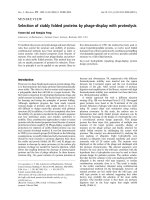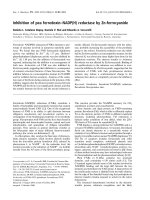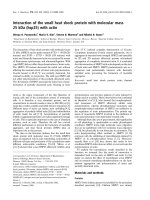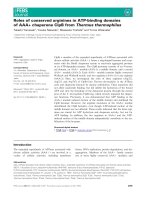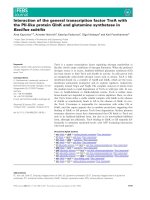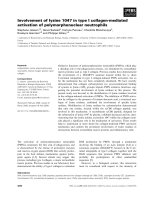Báo cáo khoa học: "Interaction of Knowledge Sources in a Portable Natural Language Interface" docx
Bạn đang xem bản rút gọn của tài liệu. Xem và tải ngay bản đầy đủ của tài liệu tại đây (294.93 KB, 4 trang )
Interaction of Knowledge Sources in a
Portable Natural Language Interface
Carole D. Hafner
Computer Science Department
General Motors Research Laboratories
Warren, MI 48090
Abstract
This paper describes a general approach to the
design of natural language interfaces that has
evolved during the development of DATALOG, an Eng-
lish database query system based on Cascaded ATN
grammar. By providing separate representation
schemes for linguistic knowledge, general world
knowledge, and application domain knowledge,
DATALOG achieves a high degree of portability and
extendability.
1. Introduction
An area of continuing interest and challenge in
computational linguistics is the development of
techniques for building portable natural language
(NL) interfaces (See, for example, [9,3,12]). The
investigation of this problem has led to several
NL systemS, including TEAM [7], IRUS [i], and
INTELLECT [10], which separate domain-dependent
information from other, more general capabilities,
and thus have the ability to be transported from
one application to another. However, it is impor-
tant to realize that the domain-independent por-
tions of such systems constrain both the form and
the content of the domain-dependent portions.
Thus, in order to understand a system's capabili-
ties, one must have a clear picture of the
struc-
ture of interaction among these modules.
This paper describes a general approach to the
design of NL interfaces, focusing on the
structure
of interaction among the components of a portable
NL system. The approach has evolved during the
development of DATALOG (for "database dialogue")
an esperimental system that accepts a wide variety
of English queries and commands and retreives the
answer from the user's database. If no items sat-
isfy the user's request, DATALOG gives an informa-
tive response explaining what part of the query
could not be satisfied. (Generation of responses
in DATALOG is described in another report [6].)
Although DATALOG is primarily a testbed for
research, it has been applied to several demon-
stration databases ~nd one "real" database con-
taining descriptions and rental information for
more than 500 computer hardware units.
The portability of DATALOG is based on the
independent specification of three kinds of knowl-
edge that such a system must have: a linguistic
grammar of English; a general semantic model of
database objects and relationships; and a domain
model representing the particular concepts of the
application domain. After giving a brief overview
of the architecture of DATALOG, the remainder of
the paper will focus on the interactions among the
components of the system, first describing the
interaction between syntax and semantics, and then
the interaction between general knowledge and
domain knowledge.
2. Overview of DATALOG Architecture
The architecture of DATALOG is based on Cas-
caded ATN grammar, a general approach to the
design of language processors which is an exten-
sion of Augmented Transition Network grammar [13].
The Cascaded ATN approach to NL processing was
first developed in the RUS parser [2] and was for-
mally characterized by Woods [14]. Figure 1 shows
the architecture of a Cascaded ATN for NL process-
ing: the syntactic-and semantic components are
implemented as separate processes which operate in
parallel, communicating information back and
forth. This communication (represented by the
"interface" portions of the diagram) allows a lin-
guistic ATN grammar to interact with a semantic
processor, creating a conceptual representation of
the input in a step-by-step manner and rejecting
semantically incorrect analyses at an early stage.
DATALOG extends the architecture shown in Fig-
ure 1 in the direction of increased portability,
by dividing semantics into two parts (see Figure
2). A "general" semantic processor based on the
relational model of data [5] interprets a wide
variety of information requests applied to
input
ATN
GRAMMAR
interface
)
combined syntactic/
semantic analysis
interface
SEMANTICS
Figure i. Cascaded Architecture for
Natural Language Processing
57
ATN
input combined syntactic/
semantic analysis
interface
1
Figure 2. Architecture Of DATALOG
abstract database objects. This level of knowl-
edge is equivalent to what Hendrix has labelled
"pragmatic grammar" [9]. Domain knowledge is rep-
resented in a semantic network, which encodes the
conceptual structure of the user's database.
These two levels of knowledge representation ar~
linked together, as described in Section 4 below.
The output of the cascaded ATN grammar is a
combined linguistic and conceptual representation
of the query (see Figure 3), which includes a
"SEMANTICS" component along with the usual lin-
guistic constituents in the interpretation of each
phrase.
3. Interaction of Syntax and Semantics
The DATALOG interface between syntax and seman-
tics is a simplification of the RUS approach,
which has been described in detail elsewhere [ii].
The linguistic portion of the interface is imple-
Pushing for Noun Phrase.
ASSIGN Actions :
employee
employee
employee
employee
Popping Noun Phrase:
(NP
(DET (the))
mented by adding a new arc action called "ASSIGN"
to the ATN model of grammar. ASSIGN communicates
partial linguistic analyses to a semantic inter-
preter, which incrementally creates a conceptual
representation of the input. If an assignment is
nonsensical or incompatible with previous assign-
ments, the semantic interpreter can reject the
assignment, causing the parser to back up and try
another path through the grammar.
In DATALOG, ASSIGN is a function of three argu-
ments: the BEAD of the current clause or phrase,
the CONSTITUENT which is being added to the inter-
pretation of the phrase, and the SYNTACTIC SLOT
which the constituent occupies. As a simplified
example, an ATN gram, mr might process noun phrases
by "collecting" determiners, numbers, superlatives
and other pre-modifiers in registers until the
head noun is found. Then the head is assigned to
the NPHEAD slot; the pre-modifiers are assigned
(in reverse order) to the NPPREMOD slot; superla-
tives are assigned to the SUPER slot; and numbers
are assigned to the NUMBER slot. Finally, the
determiners are assigned to the DETERMINER slot.
If all of these assignments are acceptable to the
s~m~ntic interpreter, an interpretation is con-
structed for the "base noun phrase", and the par-
ser can then begin to process the noun phrase
post-modifiers. Figure 3 illustrates the inter-
pretation of "the tallest female employee",
according to this scheme. A more detailed
description of how DATALOG constructs interpreta-
tions is contained in another report [8].
During parsing, semantic information is col-
lected in "semantic" registers, which are inacces-
sible (by convention) to the grammar. This con-
vention ensures the generality of the grammar;
although the linguistic component (through the
assignment mechanism) controls the information
that is passed to the semantic interpreter, the
only information that flows back to the grazm~ar is
CONSTITUENT
SYNTACTIC SLOT
employee NPHEAD
(AMOD female) NPPREMOD
(ADJp SUPER
(ADV most)
(ADJ tall))
(the) DET
(PREMODS ((ADJP (ADV most) (ADJ tall)) (AMOD female))
(HEAD employee)
(SEMANTICS
(ENTITY
(Q nil)
(KIND employee)
(RESTRICTIONS (
((ATT sex) (RELOP ISA) (VALUE female))
((ATT height) (RANKOP MOST) (CUTOFF i)) )))))
Figure 3. Interpretation of "the tallest female employee".
58
the acceptance or rejection of each assignment.
When
the
grammar builds a constituent structure
for a phrase or clause, it includes an extra con-
stituent called "SEMANTICS", which it takes from a
semantic register. However, generality of the
grammar is maintained by forbidding the gra~mmar to
examine the contents of the SEMANTICS constituent.
4. Interaction of General and Application
Semantics
The semantic interpreter is divided into two
levels: a "lower-level" semantic network repre-
senting the objects and relationships in the
application domain; and a "higher-level" network
representing general knowledge about database
structures,
data analysis, and information
requests. Each node of the domain network, in
addition to its links with other domain concepts,
has a "hook" attaching it to the higher-level con-
cept of which it is an instance. Semantic proce-
dures are also attached to the higher-level con-
cepts; in this way, domain concepts are indirectly
linked to the semantic procedores
that
are used to
interpret them.
Figure ¢ illustrates the relationship between
the general concepts of DATALOG and the domain
semantic network of a personnel application.
Domain concepts such as "female" and "dollar" are
attached to general concepts such as /SUBCLASS/
and /UNIT/. (The higher-level concepts are delim-
ited by slash "/" characters.) When a phrase such
as "40000 dollars" is analyzed, the semantic
procedures for the general concept
,'b~::T/
are
invoked to interpret it.
The general concepts also organized ~nto a net-
work, which supports inheritance of s~msntic pro-
cedures. For example, two of the general concepts
in DATALOG are /ATTR/, which can represent any
attribute in the database, and /NUMATTR/, which
represents numeric
attributes
such as "salary" and
"age". Since /ATTR/ is the parent of /NUMATTR/ in
the general concept network, its semantic proce-
dures are automatically invoked when required dur-
ing interpretation of a phrase whose head is a
numeric attribute. This occurs whenever no
/NUMATTR/ procedure exists for a given syntactic
slot; thus, sub-concepts can be defined by specif-
ying only those cases where their interpretations
differ from the parent.
Figure 5 shows the same diagram as Figure 4,
with concepts from the computer hardware database
substituted for personnel concepts. This illus-
trates how the semantic procedures that inter-
preted personnel queries can be easily transported
to a different domain.
5. Conclusions
The general approach we have taken to defining
the inter-component interactions in DATALOG has
led to a high degree of extendability. We have
been able to add new sub-networks to the grammar
without making any changes in the semantic inter-
preter, producing correct interpretations (and
correct answers from the database) on the first
try. We have also been able to implement new gen-
eral semantic processes without modifying the
grammar, taking advantage of the "conceptual fac-
toring" [14] which is one of the benefits of the
Cascaded ATN approach.
The use of a two-level semantic model is an
experimental approach that further adds to the
portability of a Cascaded ATN grammar. By repre-
senting application concepts in an "epistemologi-
cal" s~m~ntic network with a restricted set of
primitive links (see Brao~un [4]), the task of
building a new application of DATALOG is reduced
to defining the nodes and connectivity of this
network and the synonyms for the concepts repre-
Which female Ph.D.s earn more than 40000 dollars
female ' male Ph.D. masters earn
i, Sex
]
I-degree
i I I salary
i
I ploy-i
Figure 4. Interaction of Domain and General Knowledge
'59
sented by the nodes. Martin et. al. [12] define a
transportable NL interface as one
that
can acquire
a new domain model by interacting with a human
database expert. Although DATALOG does not yet
have such a capability, the two-level semantic
model
provides a foundation for it.
DATALOG is still under active development, and
current research activities are focused on two
problem areas: extending the two-level semantic
model to handle more complex databases, and inte-
grating a pragmatic component for handling ana-
phora and other dialogue-level phenomena into the
Cascaded ATN grammar.
1.
6. References
Bates, M. and Bobrow, R. J., "Information
Retrieval Using a Transportable Natural Lan-
guage Interface." In Research and Development
in Information Retrieval: Proc. Sixth Annual
International ACM SIGIR Conf., Bathesda MD,
pp. 81-86 (1983).
2. Bobrow, R. "The RUS System." In "Research in
Natural Language Understanding," BBN Report
No. 3878. Cambridge, MA: Bolt Beranek and
Newman Inc. (1978).
3. Bobrow, R. and Webber, B. L., "Knowledge Rep-
resentation for Syntactic/Semantic Process-
ing." In Proc. of the First Annual National
Conf. o.nn Artificial Intelligence, Palo Alto
CA, pp. 316-323 (1980).
4. Brachman, R. 3., "On the Epistemological Sta-
tus of Semantic Networks." In Associative Net-
works: Representation and Use of Knowledge by
Computers, pp. 3-50. Edited by N. Y. Findler,
New York NY (1979).
5. Codd, E. F. "A Relational Model of Data for
Large Shared Data Banks." Communications of
th_.~e ACM,
Vol. 13, No. 6, pp.377-387 (1970).
6. Godden, K. S., "Categorizing Natural Language
Queries for Int~lllgent Responses." Research
Publication 4839, General Motors Research Lab-
oratories, Warren MI (1984).
7. Grosz, B. J., "TEAM: A Transportable Natural
Language Interface System." In Proc. Conf. on
Applied Natural Language Processing, Santa
Monica CA, pp. 39-45 (1983).
8. Hafner, C. D. and Godden, K. S., "Design of
Natural Language Interfaces: A Case Study."
Research Publication 4587, General Motors
Research Laboratories, Warren MI (1984).
9. Hendrix, G. G. and Lewis, W. H., "Transporta-
ble Natural Language Interfaces to Data."
Proc. 19th Annual Meeting of theAssoc, fo__~r
Computational Linguistics, 5tanford CA, pp.
159-165 (1981).
10. INTELLECT Query System User's Guide, 2nd. Edi-
tion. Newton Centre, MA: Artificial Intelli-
gence Corp. (1980).
11. Mark, W. S. and Barton, G. E., "The RUSGRAMMAR
Parsing System." Research Publication
GMR-3243. Warren, MI: General Motors Research
Laboratories (1980).
12. Martin, P., Appelt, D., and Pereira, F.,
"Transportability and Generality in a Natural-
Language Interface System." In Proc. Eight
International Joint Conf. on Artificial Intel-
ligence, Karlsruhe, West Germany (1983).
13. Woods, W. "Transition Network Grammars for
Natural Language Analysis." Cowmunications of
the ACM, Vol. 13, No. 10, pp. 591-606 (1970).
14. WOodS, W., "Cascaded ATN Gra/~nars." American
Journal of Computational Linguistics," Vol. 6,
No. 1, pp. 1-12 (1980).
Which IBM terminals weigh more than 70 pounds
val o val_of verb o ' unit of
/
Figure 5. Figure 4 Transported to a New Domain
60



